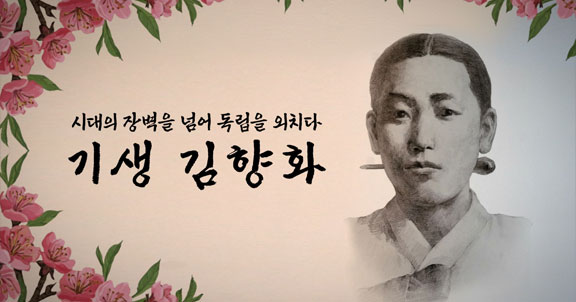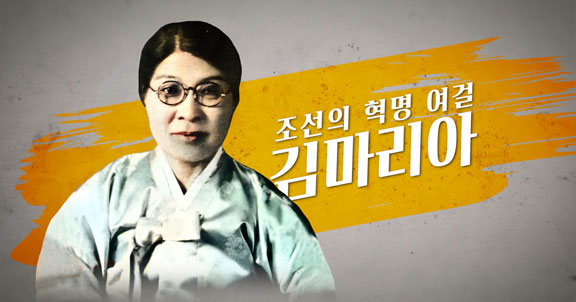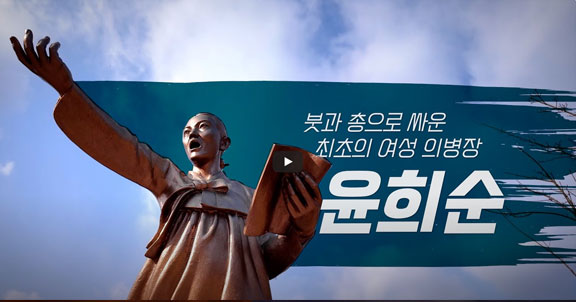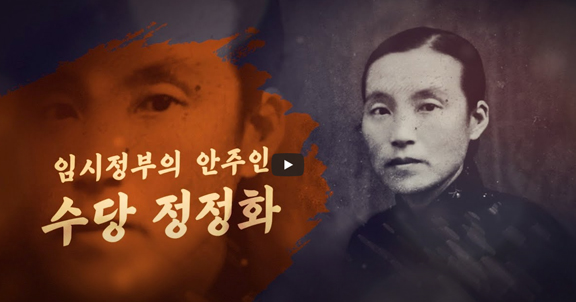여성독립운동가 영상 캠페인

- 제목
- 임시정부의 안주인, 수당 정정화
- 내용
-
대한의 여성들.
이름 석자보다 누군가의 어머니, 누군가의 아내로만 알려진 숨은 독립운동가들.
임시정부의 안주인이자 보이지 않는 버팀목이었던 수당 정정화 역시 그랬습니다.
누구도 선뜻 나설 수 없던 일에 스무살 정정화는 맨몸으로 뛰어듭니다.
조국을 위한 일념 하나로 목숨을 건 자금 조달 임무를 무사히 성공시키고, 국경을 넘나드는 수당의 계속된 활약은 임시정부의 새로운 동력이 됩니다.
나라를 구하는 일에 남녀가 따로 있지 않았습니다.
보이지 않는 희생으로 독립에 몸바친 수많은 조선의 딸, 조선의 어머니들…
그들을 잊지 않고 꼭 기억하겠습니다.
- Subject
- The lady of the Provisional Government, Sudang Jeong, Jeong-Hwa
- Contents
-
The women of Korea.
The hidden independence activists were known more as someone’s mother or wife than their names.
Jeong, Jeong-Hwa was a lady and a hidden prop of the Provisional Government.
Twenty-year-old Jeong dived into a mission that no one else was willing to do.
Risking her life for the sake of her country, she successfully completed the funding mission.
Her continued work across the border brought new momentum to the Provisional Government.
Saving the country was not a man’s job.
Korea’s countless daughters and mothers gave their lives for independence with invisible sacrifices.
We shall always remember their names and remember them.
- 제목
- 붓과 총으로 싸운 최초의 여성 의병장 윤희순
- 내용
-
3.1운동으로 대표되는 우리 민족의 독립 정신, 그 모태는 무엇일까요?
바로 의병입니다.
그 중에서도 19세기 말, 시대의 틀을 깨고 등장한 최초의 여성 의병장 윤희순을 주목해야 합니다.
스스로를 ‘조선 선비의 아내’라 부른 그녀는 붓을 들어 일제에 경고하고, 의병가를 직접 지어 부르며 민중의 항일 의식을 불러 일으켰습니다.
또한 안사람 의병단을 조직하여 총을 들고 전장에 뛰어들기도 했습니다.
서간도로 망명 후에도 독립 운동 인재를 양성하고, 조선독립단을 조직해 싸우는 등 40년의 시간을 독립을 위해 바쳤습니다.
윤희순을 시작으로 많은 여성독립운동가들이 등장해 활약했지만 독립운동사에서 여성의 존재는 그들의 헌신에 비해 아직 미약하기만 합니다.
올해 105주년 3.1절을 맞아 여성독립운동가들을 기억하는 시간을 가져보면 어떨까요?
- Subject
- Yun Hui-sun, First Female Commander of a Civilian Militia
- Contents
-
What epitomized Korea’s spirit of independence displayed so passionately at the March 1st Movement? The civilian militias known as ‘Righteous armies.’
During the late 19th century, there was a figure that was unprecedented in her time: Yun Hui-sun, the first female commander of a righteous army.
She used her brush to speak unflinchingly to Japanese forces and signed warnings with her name. Yun Hui-sun not only wrote battle songs, she actually armed herself and fought as well. Even after having to retreat out of the country, she educated activists and assembled independence corps. For 40 years, she devoted herself to the fight for independence.
Many female freedom fighters followed in her wake, but the role and dedication of women in Korea’s history of independence is still not well known. This video is a tribute to these women and the hope that more light will be shone on them on this 105th anniversary of Korea’s March 1st Movement.
- 제목
- 조선의 혁명 여걸 김마리아
- 내용
-
기미년 3.1운동에 앞서 1919년 2월 8일, 일제의 심장부 도쿄에서 최초의 독립선언이 있었습니다.
재일 조선 유학생들이 독립 만세를 외친 그날의 현장에 청년 김마리아가 있었습니다.
일본 유학 생활 중에도 한복을 고집할 정도로 투철했던 민족의식이 독립운동으로 이어진 것입니다.
김마리아는 일제의 감시가 심한 남성을 대신해 자신이 직접 기모노를 입고 2.8독립선언서를 숨겨 반입에 성공했고 전국 각지에 배포했습니다.
이것이 기폭제가 되어 일어난 3.1운동은 여성들이 사회 전면에 등장하게 됐다는 점에서 중요한 의미를 갖습니다.
김마리는 이후 여성 비밀결사인 대한민국 애국부인회를 조직해 국내외에 지부를 설치하고, 군자금을 모아 임시정부에 전달하는 등의 성과를 올렸습니다.
그러나 동료의 배신으로 김마리아는 일제에 체포됐고 고문으로 인해 한 쪽 가슴을 잃어 평생 안섶과 겉섶의 길이가 다른 저고리를 입어야만 했습니다. 심각한 고문 후유증으로 대수술과 치료를 이어가던 중 그녀는 비밀리에 망명길에 올라 상해 임시정부에 합류했습니다.
대한민국임시정부는 임시 헌장에 남녀 평등과 여성의 참정권을 명시하며 국민이 국가의 주인임을 선포했고, 김마리아는 임시의정원에서 최초의 여성의원으로 당선되며 여성으로서 위대한 발걸음을 내딛게 됩니다. 자주독립의 핵심은 교육에 있다고 생각한 김마리아는 미국 유학길에 오릅니다. 유학 중에도 여성 독립운동 단체 근화회의 회장을 맡고, 흥사단에서 활동하는 등 독립운동의 선봉에 섰습니다.
불혹의 나이가 되어서야 조국의 품에 돌아온 김마리아는 일제의 창씨개명과 신사참배 강요를 거부하는 등 항거를 이어갔지만 평생을 괴롭혀온 고문의 후유증을 넘지 못하고 1944년 3월 13일, 한 줌의 재가 되어 잠들고 맙니다.
그녀가 남기고 간 것은 낡은 수저 한 벌 뿐이었습니다. 당대 최고의 엘리트 신여성이었지만 탄탄대로의 삶을 포기하고 일생을 홀로 독립운동에 바친 김마리아.
11월 17일 순국선열의 날을 맞아 김마리아의 애국정신을 다시 한번 되새겨 볼까요?
- Subject
- Kim Maria, the revolutionary woman from Korea
- Contents
-
On February 8, 1919, the first Declaration of Independence was made in Tokyo, the heart of Japan, ahead of the March 1st Independence Movement.
Young Kim Maria was there that day when Korean students in Japan cheered "Long Live Korean Independence!"
Her firm belief in her own national identity, which prompted her to wear a hanbok while studying in Japan, eventually inspired her participation in the independence movement.
Instead of a man closely monitored by the Japanese authorities, she successfully brought the February 8 Declaration of Independence into Korea hidden in her kimono and spread it throughout the country.
This served as a trigger for the March 1st Independence Movement, which was significant because it brought women to the forefront of society.
Kim Maria later organized a women's secret group, the Korean Patriotic Women's Association, and established branches both domestically and internationally to raise military funds and transfer them to the provisional government.
However, because of her colleague's betrayal, she was captured by the Japanese. She lost a breast due to torture, and as a result, had to wear a jeogori with mismatched inner and outer layers for the remainder of her life.
While undergoing major surgery and treatment for the severe aftereffects of the torture, she secretly went into exile and joined the Provisional Government of Korea in Shanghai.
The Provisional Government of the Republic of Korea declared in its provisional charter that the people are the true owners of the state, emphasizing gender equality and the right to vote for women.
Kim Maria was elected as the first female member of the Provisional Assembly, marking a significant milestone for women.
Believing that education was crucial for achieving independence, she traveled to the United States to pursue her studies.
During her time studying in another country, she played a key role in the independence movement by acting as the president of the Women's Independence Movement Group, Geunhwahoe, and actively engaging in Heungsadan.
Returning to her homeland at the age of forty, she persistently resisted by declining to take on a Japanese name and refusing the mandatory visits to the shrine.
However, she was unable to overcome the lingering effects of the torture that had haunted her throughout her life. On March 13, 1944, she passed away, becoming a handful of ashes.
All she left behind was an old spoon and a pair of chopsticks.
Despite being the most prominent new woman of her era, she chose to sacrifice a bright future in order to fully commit herself to the independence movement.
On November 17, the Day of the Patriotic Martyrs, let’s once again reflect on Kim Maria's spirit of patriotism.
- 제목
- 독립군 여전사 박차정
- 내용
-
1919년, 탑골공원에서 시작된 민족 최대 규모의 독립운동 3.1운동은 빠르게 한반도 전역으로 퍼졌고
만세의 함성은 3월 11일, 대한민국 제2의 도시 부산에서 이어졌습니다.
부산 최초의 만세운동이 일어난 부산진일신여학교는 여교사와 여학생이 주도했다는 점에서 독립운동사에 중요한 의미를 갖습니다. 독립군 여전사 박차정 의사 역시 일신여학교가 낳은 여성 독립 영웅의 한 명입니다. 박차정 의사는 학창 시절 항일의식이 담긴 소설을 쓰고, 일제의 교육정책에 저항한 동맹휴교에 앞장서는 등 준비된 독립운동가였습니다.
1929년 광주학생독립운동은 제2의 3.1운동으로 불리며 서울여학생만세운동으로 이어졌습니다.
이것을 주도한 것은 통합 항일 여성운동 단체인 근우회였는데, 박차정은 이 근우회의 핵심 간부로 배후에서 이 운동을 지도하고 있었습니다. 그러나 일제의 탄압으로 체포됐고, 두 번의 구금과 잔인한 고문으로 건강이 급격히 악화됐습니다. 이제 갓 스무 살이 된 그녀에겐 가혹한 운명이었습니다.
박차정은 민족과 여성해방을 함께 주장해 온 독립운동가였습니다. 여성들이 구시대적 속박으로부터 자유와 평등을 쟁취하기 위해선 민족의 독립이 우선이라고 생각했습니다. 박차정은 중국으로의 망명을 선택하고 항일 비밀결사 단체인 의열단에 가입합니다. 그리고 의열단장 김원봉과 혼인하며 ‘임철애’라는 새 이름을 얻습니다. 이후 조선혁명군사정치간부학교에서 교관으로 활동했고, 난징조선부녀회 창립, 만국부녀대회 대표 참가, 임시정부 특사 등으로 활약했습니다.
박차정은 이론가인 동시에 행동하는 실천가였습니다. 1937년 발발한 중일전쟁은 독립을 쟁취할 절호의 기회로 포착됐고, 이듬해 훗날 광복군으로 편입되는 조선의용대가 조직됩니다. 박차정은 22명의 여성 대원으로 구성된 부녀복무단의 단장을 맡아 선무활동뿐만 아니라 직접 총을 들고 전장으로 출격합니다. 하지만 일제의 총격을 받아 쓰러졌고 부상의 후유증을 넘지 못하고 1944년 5월 27일 눈을 감았습니다.
박차정은 유관순에 이어 두 번째로 건국훈장 독립장에 추서된 여성 독립유공자입니다. 대한민국의 오늘을 있게 한 박차정의 숭고한 희생과 지지 않는 독립 정신을 기억해 주세요.
- Subject
- Park Cha-jung, a female fighter in the Independence Army
- Contents
-
In 1919, after beginning in Tapgol Park, the March 1st Movement, the nation's largest independence movement quickly spread across the Korean peninsula,
and on March 11, it continued in Busan, the second largest city in the Republic of Korea.
The Ilshin Girls' School in Busanjin, where Busan’s first movement took place, holds great significance in the history of the independence movement as it was led by female teachers and students.
Independence activist Park Cha-jung was also one of the heroic women from the School.
She was a prepared independence activist, writing anti-Japanese novels and leading the closure of allied schools to resist Japanese education policies in her school years.
In 1929, the Gwangju Student Independence Movement which was referred to as the second March 1st Movement took place, sparking the Girl Students' Anti-Japanese Demonstration at Seoul. This was led by Geunuhoe, the Organization for Unified Anti-Japanese Women's Movement, and she was a key member of the organization, leading the movement from behind the scenes. But she was arrested due to Japanese repression and went through two detentions and brutal torture, rapidly deteriorating her health. It was a harsh fate for a woman who had just turned 20.
Park Cha-jung was an independence activist who advocated for both national and women's liberation. She believed that national independence was the first step for women to achieve freedom and equality from outdated restrictions. She decided to defect to China and joined the Heroic Corps, the anti-Japanese secret organization. After marrying Kim Won-bong, the Corp’s leader, she changed her name to Lim Chul-ae. Since then, not only working as an instructor at the Korean Revolutionary Military and Political Cadre School, but she also founded the Nanjing Korean Women's Association, participated in the International Congress of Women, and served as a special envoy to the Provisional Government.
She was an activist as well as a theorist. She saw the outbreak of the Sino-Japanese War in 1937 as a golden opportunity to fight for independence, and the following year, the Korean Volunteer Corps, which would later become the Korean Liberation Army, was organized. As the leader of a 22-member women's service corps, she was in charge of information warfare activities and also went into the middle of battles by herself. But she was hit by a Japanese bullet and unable to overcome its after-effects, passing away on May 27, 1944.
Park Cha-jung is the second female independence activist to be honored with the Independent Medal of the Order of Merit for National Foundation, after Yu Gwan-sun. Let’s remember her noble sacrifices and consistent spirit of independence that made Korea what it is today.
- 제목
- 시대의 장벽을 넘어 독립을 외치다 -기생 김향화
- 내용
-
일제강점기는 한민족 역사에서 가장 큰 시련의 시기였지만, 그 고난을 이겨내고 근대의 새 시대와 오늘의 대한민국을 만든 숨은 주역은 여성이었습니다.
3·1운동에 앞선 ‘대한독립여자선언서’ 등 역사적 주체로서 활약한 여성 독립운동가들.
그 뒤엔 신분의 한계와 차별을 딛고 조국 독립에 헌신한 또 다른 독립 영웅- 기생이 있었습니다.
려시대부터 존재했던 기생은 궁중 의식과 가무를 담당한 전문 여성 예술인으로, 시서화에도 능해 ‘해어화’로도 불렸습니다. 논개와 계월향처럼 기생은 예부터 충절과 기개를 이어왔는데 이것은 일제 강점의 풍파 앞에서도 다르지 않았습니다. 일제는 국권을 빼앗은 뒤 관기를 해체하고 그들을 상품화하며 문화 선전 도구로 전락시켰습니다. 또한 역사적 장소인 수원 화성행궁 봉수당을 자혜의원으로 만들고 기생들을 탄압하기 시작했습니다. 수원 최고의 기생 김향화는 이런 치욕 속에서도 굴하지 않았습니다. 1919년 1월, 고종의 승하 후 덕수궁을 찾아 망곡례를 올리며 나라 잃은 슬픔을 눈물로 표현했고, 그 분노는 곧 행동으로 이어졌습니다. 3월 29일, 김향화와 30여 명의 기생들은 화성행궁 내 자혜의원 앞에서 태극기를 꺼내 들고 만세를 외쳤습니다. 경찰서 앞에서도 당당히 외친 그들의 함성은 전국 각지의 기생 만세운동으로 이어졌습니다다. 김향화는 징역 6개월 형을 선고받고 서대문형무소 여옥사 8호 감방에 수감되었습니다. 일제의 혹독한 고문에도 불구하고 그녀는 그곳에서 유관순, 어윤희 등과 함께 여성 독립운동의 역사를 이어갔습니다.
2009년 독립운동가 김향화에게 대통령 표창이 추서되었지만 아직 주인을 찾지 못한 채 남아있습니다. 그녀는 가석방 후 일제의 감시를 피해 숨어 살아야 했고, 그렇게 잊혀 버렸기 때문입니다. 광복 80주년을 맞은 지금, 우리가 몰랐던 위대한 역사의 주인공을 다시 기억해 봅니다.
- Subject
- Defying the Barriers of Her Time, Crying Out for Independence – Gisaeng Kim Hyang-hwa
- Contents
-
The Japanese occupation was one of the most difficult and painful chapters in Korean history.
Yet it was women who helped overcome hardship and open the door to a new modern era, laying the foundation for today’s Korea.
Many female independence activists stood as true agents of history, such as the Korean Women's Declaration of Independence before the March 1st Movement.
Among them were others who transcended class barriers and discrimination to fight for independence - the gisaeng.
Originating in the Goryeo Dynasty, gisaeng were professional female artists who performed court ceremonies, music, and dance, and were also skilled in poetry, calligraphy, and painting, earning the title hae-eo-hwa. The noble spirit shown by gisaeng, such as Nongae and Gyewolhyang in earlier times, remained unchanged even amid the turmoil of the Japanese occupation. After seizing Korea’s sovereignty, Japan dismantled the state gisaeng system and turned them into mere commodities as tools for cultural propaganda. It also converted historic sites such as Bongsu-dang Hall at Hwaseong Haenggung Palace in Suwon into Jahye Hospital and began to suppress gisaeng.
Even amid such humiliation, Kim Hyang-hwa, the most renowned gisaeng of Suwon, remained unbowed. In January 1919, after Emperor Gojong's passing, she visited Deoksugung Palace to mourn him, shedding tears of sorrow for a lost nation. That rage soon turned into action.
On March 29, she and about thirty fellow gisaeng took out Taegeukgi flags in front of the Jahye Hospital inside the Hwaseong Haenggung Palace and cried out for independence. Their defiant shouts, even in front of the police station, sparked similar gisaeng-led independence movements across the country. She was sentenced to six months in prison and confined to Cell No. 8 in the women’s ward of Seodaemun Prison. Even under brutal torture by the Japanese, she joined other women like Yu Gwan-sun and Eo Yun-hee, continuing the legacy of the women's independence movement.
In 2009, Kim Hyang-hwa, an independence activist, was posthumously awarded the Presidential Commendation. Yet the honor remains unclaimed to this day, as she lived the rest of her life in hiding after parole, escaping Japanese surveillance, and thus, she was forgotten. Now, on the 80th anniversary of liberation, let us recall the great heroine of history whose story remained untold to many.




